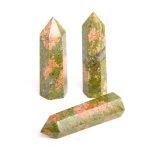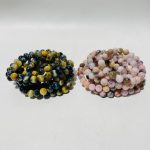Introduction
In the realm of geology, there exists a captivating class of minerals and rocks known as UV reactive rocks. These remarkable formations possess the ability to emit visible light when exposed to ultraviolet (UV) radiation. This phenomenon, known as fluorescence, transforms these rocks into vibrant and ethereal canvases, adding an extra layer of enchantment to the natural world.

The Science Behind Fluorescence
Fluorescence is a physical process that occurs when certain materials absorb energy from an external source, such as UV radiation, and subsequently release that energy as visible light. In the case of UV reactive rocks, the presence of specific chemical impurities or crystal defects creates excited states within the mineral’s structure. When UV light interacts with these excited states, the energy absorbed is re-emitted as visible light, giving rise to the characteristic glow.
Types of UV Reactive Rocks
Various minerals and rocks exhibit UV reactivity, each showcasing its unique spectral signature and fluorescence intensity. Some of the most commonly encountered UV reactive rocks include:
- Calcite: Displays vibrant orange, pink, or red fluorescence.
- Fluorite: Emits a wide range of colors, including green, blue, purple, and yellow.
- Scheelite: Known for its intense blue fluorescence, often mistaken for sapphires.
- Willemite: Exhibits a bright green fluorescence under UV light.
Benefits of UV Reactive Rocks
UV reactive rocks offer a multitude of benefits, both scientific and aesthetic:
- Geologic exploration: Aid in identifying mineral deposits and understanding geological processes.
- Mineralogical research: Provide insights into crystal structure and impurity distributions.
- Artistic applications: Create captivating jewelry, sculptures, and decorative elements.
- Educational displays: Engage students and inspire curiosity about the wonders of mineralogy.
Applications of UV Reactive Rocks
The unique properties of UV reactive rocks have sparked innovation across various industries and applications:
- Forensic science: Assist in the detection of concealed evidence, such as bloodstains or fingerprints.
- Medical diagnostics: Aid in the detection of certain diseases and disorders through fluorescent staining.
- Industrial inspection: Identify defects or impurities in materials using fluorescent dyes.
- Lighting design: Create innovative and immersive lighting experiences using UV-emitting light sources.
Table 1: Fluorescence Colors of Common UV Reactive Minerals
| Mineral | Fluorescence Color |
|---|---|
| Calcite | Orange, pink, red |
| Fluorite | Green, blue, purple, yellow |
| Scheelite | Blue |
| Willemite | Green |
| Gypsum | Yellowish-green |
| Aragonite | Pink |
| Dolomite | Brown |
| Smithsonite | Green |
| Beryl | Yellowish-green |
| Topaz | Yellow |
Motivations and Pain Points
Customers who seek out UV reactive rocks are driven by:
- Scientific curiosity: A desire to understand the geological and physical processes behind fluorescence.
- Aesthetic appreciation: A fascination with the vibrant colors and ethereal glow of UV reactive rocks.
- Practical applications: A need for innovative solutions in industries such as forensics, medicine, and lighting design.
Pain points
Customers may encounter the following pain points:
- Limited availability: Some UV reactive rocks may be rare or challenging to procure.
- Environmental concerns: Some UV-emitting light sources can emit harmful levels of radiation, requiring safety precautions.
- Cost: High-quality UV reactive rocks and specialized equipment can be expensive.
Step-by-Step Approach to Incorporating UV Reactive Rocks
- Identify the purpose: Determine the specific application or outcome desired with the use of UV reactive rocks.
- Research and select: Consult with experts in geology or mineralogy to identify the most suitable UV reactive rocks.
- Acquire the necessary equipment: Obtain a UV light source with appropriate wavelength and intensity.
- Test and optimize: Experiment with different rocks and light sources to achieve the desired fluorescence effect.
- Implement and evaluate: Incorporate UV reactive rocks into the intended application and assess the results.
Conclusion
UV reactive rocks are a testament to the marvels of nature, unlocking a hidden world of luminescence and scientific intrigue. The applications of these fascinating formations extend across diverse fields, inspiring creativity, advancing knowledge, and providing practical solutions. As we delve deeper into the realm of UV fluorescence, we can anticipate exciting new discoveries and groundbreaking innovations that illuminate our understanding of the world around us.




























